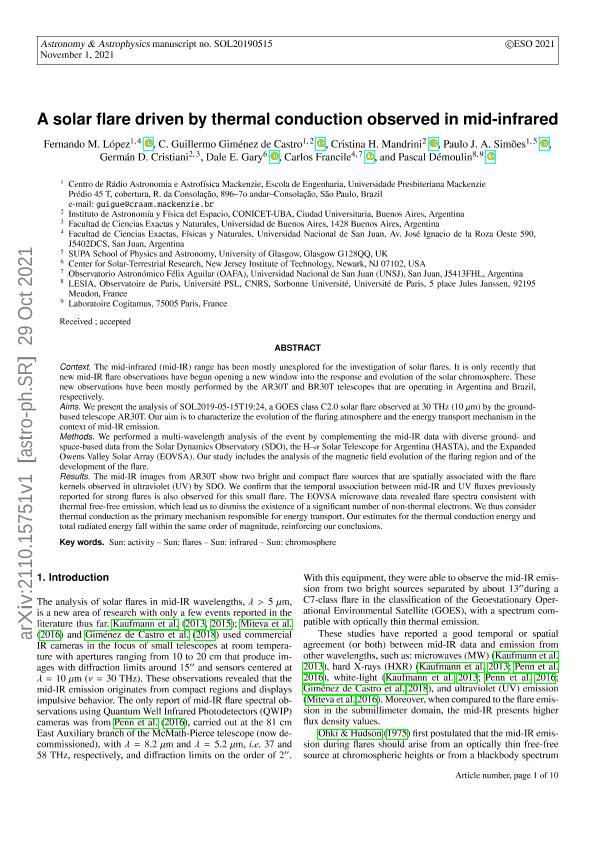Mostrar el registro sencillo del ítem
dc.contributor.author
López, Fernando Marcelo

dc.contributor.author
Giménez De Castro, Carlos Guillermo
dc.contributor.author
Mandrini, Cristina Hemilse

dc.contributor.author
Simões, Paulo J. A.
dc.contributor.author
Cristiani, Germán Diego

dc.contributor.author
Gary, Dale E.
dc.contributor.author
Francile, Carlos Natale

dc.contributor.author
Démoulin, Pascal

dc.date.available
2023-10-31T09:52:49Z
dc.date.issued
2022-01
dc.identifier.citation
López, Fernando Marcelo; Giménez De Castro, Carlos Guillermo; Mandrini, Cristina Hemilse; Simões, Paulo J. A.; Cristiani, Germán Diego; et al.; A solar flare driven by thermal conduction observed in mid-infrared; EDP Sciences; Astronomy and Astrophysics; 657; 1-2022; 1-10
dc.identifier.issn
0004-6361
dc.identifier.uri
http://hdl.handle.net/11336/216487
dc.description.abstract
Context. The mid-infrared (mid-IR) range has been mostly unexplored for the investigation of solar flares. It is only recently that new mid-IR flare observations have begun opening a new window into the response and evolution of the solar chromosphere. These new observations have been mostly performed by the AR30T and BR30T telescopes that are operating in Argentina and Brazil, respectively. Aims. We present the analysis of SOL2019-05-15T19:24, a GOES class C2.0 solar flare observed at 30 THz (10 μm) by the ground-based telescope AR30T. Our aim is to characterize the evolution of the flaring atmosphere and the energy transport mechanism in the context of mid-IR emission. Methods. We performed a multi-wavelength analysis of the event by complementing the mid-IR data with diverse ground- and space-based data from the Solar Dynamics Observatory (SDO), the H-α Solar Telescope for Argentina, and the Expanded Owens Valley Solar Array (EOVSA). Our study includes the analysis of the magnetic field evolution of the flaring region and of the development of the flare. Results. The mid-IR images from AR30T show two bright and compact flare sources that are spatially associated with the flare kernels observed in ultraviolet (UV) by SDO. We confirm that the temporal association between mid-IR and UV fluxes previously reported for strong flares is also observed for this small flare. The EOVSA microwave data revealed flare spectra consistent with thermal free-free emission, which lead us to dismiss the existence of a significant number of non-thermal electrons. We thus consider thermal conduction as the primary mechanism responsible for energy transport. Our estimates for the thermal conduction energy and total radiated energy fall within the same order of magnitude, reinforcing our conclusions.
dc.format
application/pdf
dc.language.iso
eng
dc.publisher
EDP Sciences

dc.rights
info:eu-repo/semantics/openAccess
dc.rights.uri
https://creativecommons.org/licenses/by-nc-sa/2.5/ar/
dc.subject
SUN: ACTIVITY
dc.subject
SUN: CHROMOSPHERE
dc.subject
SUN: FLARES
dc.subject
SUN: INFRARED
dc.subject.classification
Astronomía

dc.subject.classification
Ciencias Físicas

dc.subject.classification
CIENCIAS NATURALES Y EXACTAS

dc.title
A solar flare driven by thermal conduction observed in mid-infrared
dc.type
info:eu-repo/semantics/article
dc.type
info:ar-repo/semantics/artículo
dc.type
info:eu-repo/semantics/publishedVersion
dc.date.updated
2023-10-26T15:21:15Z
dc.journal.volume
657
dc.journal.pagination
1-10
dc.journal.pais
Francia

dc.journal.ciudad
Paris
dc.description.fil
Fil: López, Fernando Marcelo. Universidade Presbiteriana Mackenzie. Escola de Engenharia. Centro de Radio Astronomia e Astrofisica; Brasil. Universidad Nacional de San Juan; Argentina
dc.description.fil
Fil: Giménez De Castro, Carlos Guillermo. Universidade Presbiteriana Mackenzie. Escola de Engenharia. Centro de Radio Astronomia e Astrofisica; Brasil. Consejo Nacional de Investigaciónes Científicas y Técnicas. Oficina de Coordinación Administrativa Ciudad Universitaria. Instituto de Astronomía y Física del Espacio. - Universidad de Buenos Aires. Facultad de Ciencias Exactas y Naturales. Instituto de Astronomía y Física del Espacio; Argentina
dc.description.fil
Fil: Mandrini, Cristina Hemilse. Consejo Nacional de Investigaciones Científicas y Técnicas. Oficina de Coordinación Administrativa Ciudad Universitaria. Instituto de Astronomía y Física del Espacio. - Universidad de Buenos Aires. Facultad de Ciencias Exactas y Naturales. Instituto de Astronomía y Física del Espacio; Argentina
dc.description.fil
Fil: Simões, Paulo J. A.. Universidade Presbiteriana Mackenzie. Escola de Engenharia. Centro de Radio Astronomia e Astrofisica; Brasil
dc.description.fil
Fil: Cristiani, Germán Diego. Consejo Nacional de Investigaciones Científicas y Técnicas. Oficina de Coordinación Administrativa Ciudad Universitaria. Instituto de Astronomía y Física del Espacio. - Universidad de Buenos Aires. Facultad de Ciencias Exactas y Naturales. Instituto de Astronomía y Física del Espacio; Argentina
dc.description.fil
Fil: Gary, Dale E.. New Jersey Institute of Technology; Estados Unidos
dc.description.fil
Fil: Francile, Carlos Natale. Universidad Nacional de San Juan. Facultad de Ciencias Exactas Físicas y Naturales. Departamento de Informática. Observatorio Astronómico Félix Aguilar; Argentina
dc.description.fil
Fil: Démoulin, Pascal. Centre National de la Recherche Scientifique; Francia
dc.journal.title
Astronomy and Astrophysics

dc.relation.alternativeid
info:eu-repo/semantics/altIdentifier/url/https://www.aanda.org/10.1051/0004-6361/202141967
dc.relation.alternativeid
info:eu-repo/semantics/altIdentifier/doi/http://dx.doi.org/10.1051/0004-6361/202141967
Archivos asociados
